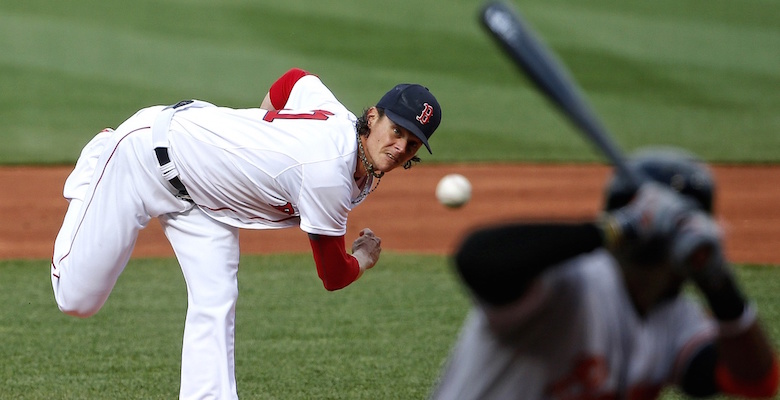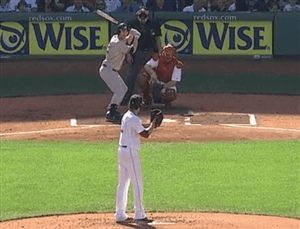I think a good curveball is hard to hit partly because of deception — probably, any successful pitch is successful partly because of deception. But curveballs may belong in a different category, where deception is less important than it is, say, for a changeup. Maybe there are “deception” curveballs — ones that look to a hitter like they could be called strikes, getting whiffs even though they end up below the zone. But there is probably a second kind of curve — call it a Challenge Curve — for which spotting location like a fastball is more important, and which are simply harder to hit. So far in his career, Clay Buchholz has used his curve as a Deception Curve, and batters have slugged a meek .338 against it. Could he use his curve as a Challenge Curve more of the time?
Deception Curveballs — if they exist as a discrete category — probably must be thrown down in the zone to work the way they’re supposed to work. It may be that there aren’t a ton of pitchers like Ted Lilly, for whom fastball velocity is slow enough (and fastballs lobbed high enough) to obscure curveballs that are high. If you threw a Deception Curveball high — at least, if you made a habit of it — it would look like a curveball almost right out of your hand. But if you are throwing a Challenge Curveball, and are daring a hitter to take a swing? Maybe that’s a lot less important.
Could it make sense to throw Challenge Curveballs high, especially high and inside? I haven’t watched a ton of Nippon Professional Baseball, but what I have seen (much of it Kenta Maeda, recently) seems to suggest that Japanese pitchers may be more willing to throw curveballs high. It’s hard to speed up one’s swing for an up-and-in fastball, but I’m not so sure that timing a curveball there is much easier.
If pitchers almost exclusively aim their curve at or below the bottom of the zone, then it stands to reason that a higher proportion of high curveballs are hung curveballs.
If high curveballs aren’t generally thrown on purpose in MLB, then there is a reason to think that they could be better than they have been. If pitchers almost exclusively aim their curve at or below the bottom of the zone, then it stands to reason that a higher proportion of high curveballs are hung curveballs. Throw your curve toward the bottom of the zone, and you may benefit from some deception, but risk hanging a curve right over the heart of the plate. Throw it high, and maybe you lose much or all of that deception — but if you hang one, it might hang too high for a hitter to do anything but take it for a ball.
For a Coors Field study, Dan Rozenson published some averages for curveball movement, and for now, I’m going to use -3 inches of vertical break as the dividing line between a Hung Curveball and a curveball that probably ended up pretty close to where it was intended. Based on that definition, here are how the 5,164 pitches classified as curveballs by MLBAM through Friday’s games break down:
| Location | “Good” Curves | Hung Curves | Hung% |
| Out Zone – High | 547 | 181 | 24.9% |
| Zone – High | 258 | 92 | 26.3% |
| Zone – Middle | 474 | 200 | 29.7% |
| Zone – Low | 604 | 217 | 26.4% |
| Out Zone – Low | 1912 | 701 | 26.8% |
| Totals | 3793 | 1391 | 26.9% |
Not many differences. But look how some “good” outcomes for the “good” curveballs (next table) compare to rates for the “hung” versions (after that):
| “Good” Curves | % | Called Strike% | Whiff% | Foul% | “Good Outcome” |
| Out Zone – High | 14.4% | 17.2% | 1.3% | 3.3% | 21.8% |
| Zone – High | 6.8% | 58.9% | 3.5% | 7.6% | 70.0% |
| Zone – Middle | 12.5% | 44.7% | 5.7% | 17.3% | 67.7% |
| Zone – Low | 15.9% | 32.9% | 9.1% | 20.9% | 62.9% |
| Out Zone – Low | 50.4% | 6.0% | 16.0% | 10.3% | 32.3% |
| Totals | N/A | 20.3% | 10.6% | 11.7% | 42.6% |
| “Hung” Curves | % | Called Strike% | Whiff% | Foul% | “Good Outcome” |
| Out Zone – High | 13.0% | 11.6% | 7.2% | 8.3% | 26.5% |
| Zone – High | 6.6% | 50.0% | 5.4% | 16.3% | 71.7% |
| Zone – Middle | 14.4% | 46.5% | 6.0% | 20.0% | 72.5% |
| Zone – Low | 15.6% | 28.1% | 13.4% | 21.2% | 62.7% |
| Out Zone – Low | 50.4% | 5.6% | 14.4% | 10.6% | 30.6% |
| Totals | N/A | 18.7% | 11.5% | 13.7% | 43.9% |
One thing I think we can say — umpires are willing and able to call high curveballs strikes. Of the 51 “hung” curves thrown in the top third of the zone without a swing, just five were called balls, the other 46 strikes. Of the 180 “good” curves in the top third of the zone without a swing, just 28 were called balls. It certainly looks like trying to throw curveballs high at least could work, and that they will make the count one strike deeper most of the time. Do pitchers pay some kind of hard-hit price?
Maybe it’s the case that when curveballs at the top of the zone are hit, they’re hit harder or longer. Here’s what we’ve seen through last Friday:
| Location | “Good” Curves | “Good” Bases/BIP | “Hung” Curves | “Hung” Bases/BIP |
| Out Zone – High | 547 | .208 | 181 | .182 |
| Zone – High | 258 | .469 | 92 | .280 |
| Zone – Middle | 474 | .603 | 200 | .574 |
| Zone – Low | 604 | .346 | 217 | .569 |
| Out Zone – Low | 1912 | .397 | 701 | .492 |
In our smallish 2015 sample, “good” curves appear to have been hit harder than curves below the zone, but not by a whole lot. And whether it’s the size of the sample or not, there’s no screaming warning for us from “hung” curveballs high in the zone. And if you’ve come with me thus far — what if we can think of a curve meant for one location as fitting into the location above it if hung? If that’s the case, there’s definitely much more to worry about by hanging a curve meant for below the zone then there is about hanging one meant for the top of the zone.
As with all sequencing questions, we have no reason to think (and maybe every reason to doubt) that any of the rates in any of the above tables would stay anything near the same if pitchers started throwing their curveballs higher. If part of it is that hitters just don’t see that many, however, maybe some pitchers can capitalize on that.
Can Clay Buchholz be that pitcher? His bender does have the look of being an effective Challenge Curveball, as it did here in a Chase Headley strikeout at the end of last season:
Here is the breakdown of Buchholz’s career curveballs:
| Location | % of Curves in Location | Called Strike% | Whiff% | Foul% | In Play% | Ball% | Bases/BIP |
| Out Zone – High | 20.4% | 20.5% | 1.4% | 3.5% | 4.7% | 69.9% | .250 (5/20) |
| Zone – High | 9.0% | 64.2% | 4.8% | 9.6% | 13.9% | 7.5% | .393 (11/28) |
| Zone – Middle | 16.9% | 49.9% | 3.7% | 17.1% | 27.9% | 1.4% | .684 (67/98) |
| Zone – Low | 13.7% | 33.6% | 8.0% | 21.3% | 21.3% | 15.7% | .443 (27/61) |
| Out Zone – Low | 40.0% | 7.1% | 16.7% | 10.2% | 7.1% | 58.9% | .356 (21/59) |
| Totals | 2082 | 25.8% | 9.1% | 11.5% | 12.7% | 40.9% | .492 (131/266) |
Out of the zone low, a Buchholz curveball may have added to the strike count 34% of the time, and it only ended up in play 7.1% of the time. In the strike zone but up, a curve has ended up in play almost twice as often — and yet it may have added to the strike count much more than twice as often. Curveballs high but in the zone were called strikes, swinging strikes, or foul balls 78.6% of the time, compared to 34% of the time for curves low and out of the zone. What those curveballs have lacked in whiffs, they’ve more than made up for in called strikes. And as we more or less saw in the 2015 sample, curveballs high in the zone are getting hit harder than curves below the zone, but not necessarily by much. And for Buchholz, as for pitchers in general this year, high in the zone is at least as safe a place for a curve as the low third of the zone.
It doesn’t feel like throwing curveballs higher should be a smart strategy; in his career, we’ve seen 161 swinging strikes on Buchholz’s curve at or below the bottom of the strike zone, and just 13 at or above the top of the zone. On a rate basis, however, good things have happened more frequently high in the zone than below it. Throwing the curve high more frequently — as a Challenge Curve — seems, at the very least, a worthy experiment.
Photo by Winslow Towson/USA Today Sports Images

